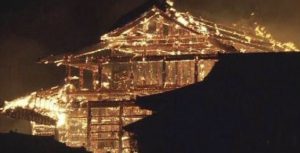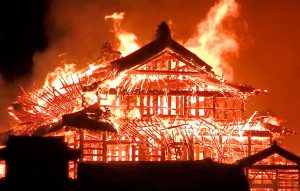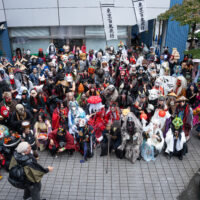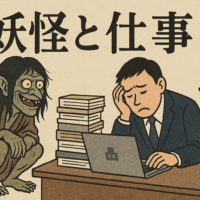
Shuri Castle and the monster (Ear-Cut Monk)
Shuri Castle is on fireThe shocking news was announced in the early hours of October 31st. The main facilities, the main hall, the north hall, and the south hall, were all completely burned down, and a total of six buildings covering approximately 4,200 square meters were destroyed.
The fire is believed to have started on the first floor on the north side of the main hall, but the exact cause is unknown as of November 4th.



Crowdfunding for the reconstruction effort has received support not only from across the country but also from overseas, and donations to Naha City have reportedly exceeded 200 million yen.
I myself had the opportunity to go to Okinawa on a business trip about seven years ago, and saw Shuri Castle on that occasion. It had a completely different atmosphere from Japanese castles and buildings, and was a place where you could really feel the unique culture of the Ryukyu Kingdom.
Shuri Castle was the royal castle that controlled the politics of the Ryukyu Dynasty, and was also the largest military facility in the prefecture.Gusuku) was also.
At the same time, Shuri CastleReligious SitesOn the south side of Shuri Castle, there is a sacred area called "Keo-no-uchi," where it is believed that women related to the royal family performed religious rites as shrine maidens.Spiritual Governance SymbolsBut it was.
Shuri Castle was maintained as a symbol of the Ryukyu Kingdom from 1429 when King Sho Hashi founded the Ryukyu Kingdom by unifying the three kingdoms until before the war, but it was destroyed by heavy bombing during the Battle of Okinawa in 1945 (Showa 20) during the Pacific War, and after the war, the University of the Ryukyus was built on the site, and the construction work caused even the remains to disappear without a trace. Later, when the University of the Ryukyus was relocated, the remains were excavated, and a restoration campaign began in the late 1980s, and the sacred area known as Shuri Castle was restored in 1992 (Heisei 4). Then, in December 2000 (Heisei 12), it was registered as a World Heritage Site as "Gusuku and Related Properties of the Kingdom of the Ryukyus".
This fire was a very unfortunate incident that resulted in the loss of an important cultural heritage of Okinawa.
I hope that this symbol of Ryukyu will be restored as soon as possible.


By the way, on November 4th, the Gassho-style village of Shirakawa-mura in Gifu Prefecture, which is registered as a World Heritage Site,Shirakawa-goHowever, there was a fire in the parking lot and the shed was completely burned down.
It's winter now, and fires are common, so you need to be careful with fires...
Lullaby of the Ear-Cut Monk
This time, we will introduce you to the monsters that are said to exist near Shuri Castle.
The "Omura Palace (currently the site of the Nakagusuku Palace)" that appears in the lullaby handed down in Okinawa Prefecture is a piece of land across from the beautiful Ryutan Pond with a view of Shuri Castle.Ear-cutting monkThere is a legend called "Mimichiribouji".
The lullaby has been passed down as follows:
At the corner of Omura Palace
Standing posture of Mimichiri-boji
How many bodies, how many bodies, stand up
Three bodies, four bodies, standing together
A crying child tickles my ears
Hey yo, hey yo, don't cry
The meaning of the song is,
How many ghosts of Mimikiri-bozu stand on the corners of Omura Palace, the village chief's mansion? There are three or even four of them.
The ears of crying children will be cut off with a sob, sob sound. Hiyo, hiyo, don't cry.
This is a song with a slightly scary message that is a bit too scary for children to listen to.
The head priest of Kurogane and Prince Chatan
The model for "Mimi-kiri-bozu" isKurogane Head PriestHe was a real Buddhist monk called Kurugani Zasu. He was a Tendai Buddhist monk, but he used sorcery to deceive the women who visited the temple and did many other bad things.
So the King said,Chatan PrinceHe orders Chatan-oji to fight a life-or-death duel with Kurogane Zashu.
Prince Chatan won the fight, and in exchange for sparing his life, he cut off the head of the monk's ear. However, the wound caused the monk to catch tetanus and die.
After the death of Kurogane Zasu, his vengeful spirit became the Mimikiri-bozu. For some reason, it is said that he has no interest in girls' ears, and only appears to target boys' ears. It is said that when a baby boy is born, the above song is sung to protect the child, and so the "Mimikiri-bozu" lullaby was created.
Incidentally, in the family of the Chatan princes, no male heirs have been born for many generations, which is believed to be the result of the curse of the Ear-Cutting Monk.
Legends created by winners
Like many yokai legends, Mimikiri-bozu is based on historical fact, but opinions seem to be divided as to whether the head priest Kurogane was actually a villain.
Some believe that because Kurogane Zasu advocated for improving the social status of the Buddhist community in Ryukyu at the time, he was purged by the Ryukyu royal government, which was implementing austerity measures.
They say that history is written by the victors, and it seems that monsters and legends are also sometimes written by the surviving victors.

Images from NHK News, Mainichi Shimbun, and Okinawa Times
Text by Keijiro Watanabe
References: "Japanese Yokai Encyclopedia" (Shigeru Mizuki, Kenji Murakami, Kadokawa Bunko)
■ Keichan Watanabe
Born in Asahikawa, Hokkaido. Graduated from the School of Human Sciences at Waseda University. An independent researcher of monsters.
He currently splits his time between Sapporo, Hokkaido, and Tokyo, and works as a management and IT consultant, but he studied folklore and cultural anthropology at university, and continues to study yokai as his life's work.
I am currently writing articles about monsters associated with Hokkaido, where I currently live, as well as current news about business and economics.
Twitter:https://twitter.com/keishiro_w








No comments yet.